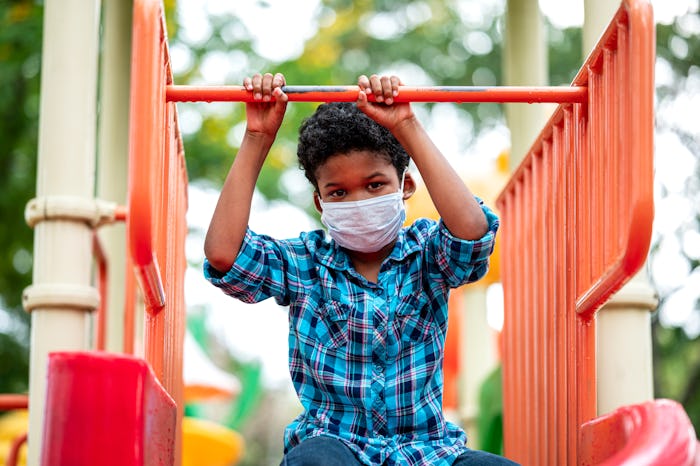Life

The "Tiny Fraction" Of Kids Trump Admits Suffer From COVID Are Largely Children Of Color
In an attempt to make the case for schools reopening, President Trump reiterated the false idea this week that children are somehow immune to COVID-19. “It’s also a case where there’s a tiny fraction of death, tiny fraction, and they get better very quickly,” Trump told a reporter during a White House press briefing on August 10, when pressed on previous comments from a Fox & Friends appearance that children are “almost" immune. “I think, for the most part, they don’t get very sick,” he told the reporter. But, they do. Children are not immune to the coronavirus and its health effects, and children of color are especially at risk of severe illness and death.
Trump's comments came the same week the American Academy of Pediatrics released a report that found more than 97,000 children tested positive for COVID-19 in the last two weeks of July, comprising 8.8% of total cases. On August 7, the CDC’s weekly mortality and morbidity report stated that Hispanic and Black children are respectively 8 and 5 times more likely to be hospitalized with severe illness from COVID-19. Despite Trump’s insistence, children do not simply “get better very quickly.”
Araceli Morales Martinez didn’t get to be with her daughter as the 8-year-old died from complications of COVID-19 on June 1 in UNC Medical Center in Chapel Hill. Aurea Soto Morales was in the hospital for four days before she died. "It's a nightmare I never imagined living," Martinez told ABC 11. Morales loved playing in the snow and dancing and was the first child to die of COVID-19 in North Carolina.
In Florida, Kimora Lynum became the youngest child to die from COVID-19 on July 18. The Black 9-year-old was sent home from the hospital with a fever and collapsed later that day, according to CNN.
Skylar Herbert, also Black, was only 5 years old when she died of COVID-19, making her the youngest victim of the virus in Michigan. On April 19, her mother, LaVondria Herbert, made the decision to take her off the ventilator she’d been on since April 4 after doctors explained she wasn’t coming back, reported the Detroit News. “I had so many plans for us, baby girl,” the mourning mother said at her daughter’s memorial service.
The “tiny fraction” of children who are most at risk of dying from COVID-19 are children of color. When children are hospitalized with COVID-19, CDC data shows they have the same risk of developing severe illness as adults. If the hospitalization and death rates for Black and Hispanic adults are any indication, the outcomes for Black and brown children are equally worrisome. The coronavirus pandemic has exposed the racial health disparities that have existed in the U.S. for decades. Black and Hispanic families are more likely to be uninsured. They are impacted by centuries of systemic inequality — a lack of economic opportunity, discrimination in health care, and racist housing policies that have left many Native American, Black, and Hispanic people largely in neighborhoods lacking resources. These generational factors, along with ongoing racist policies, also make Black and brown children more vulnerable to COVID-19.
When we talk about the health of children and those who are at risk, we cannot ignore the disparities. We certainly cannot be willing to risk the lives of Black and brown children and dismiss their deaths as a small price to pay. Any time Trump claims children are “essentially immune,” he’s not concerned with the lives of Black, Hispanic, and Native American children. No child is immune to the novel coronavirus, and to minimize the deaths of the most vulnerable Americans so casually shows disregard for children’s lives — especially children of color.
Editor’s Note: Native American and Alaska Native people have also been disproportionately affected by the coronavirus pandemic. Unfortunately, data is insufficiently collected from counties and reservations where they live, leaving statistical gaps when reporting on Native American and Alaska Native people.